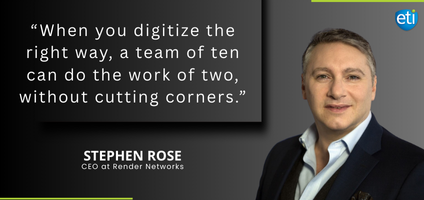
The following summary has been condensed for length and readability. To listen to the full discussion, click here. This episode is sponsored by ETI Software and VETRO FiberMap.
In this episode of The Broadband Bunch, host Brad Hine sits down with Stephen Rose, CEO of Render Networks, for a conversation that dives into the future of broadband infrastructure, the role of AI, and why digital transformation is more urgent than ever. Drawing from his experience at industry heavyweights like IBM, Nokia, and Nokia Bell Labs, Stephen shares his perspective on building smarter, more efficient networks—and how Render is helping make that a reality.
Stephen introduces listeners to Render’s evolving role in the broadband and utility landscape. While the company has long been known for digitizing and streamlining fiber deployment projects, it’s now doubling down on partnerships and platform integrations to fuel even greater efficiency.
“The future isn’t about being the only vendor in the room—it’s about being the best partner in the room,” Stephen says.
Stephen provides a grounded view of AI adoption in telecom, noting that while the buzzwords are everywhere—RAG models, generative AI, speech-to-text—the real value lies in applying AI to specific operational needs. Whether it’s forecasting project timelines, optimizing field crew scheduling, or reducing rework through automation, AI must serve the user, not the other way around.
One key takeaway? “There’s no AI without IA.” That is, artificial intelligence is meaningless without a strong information architecture and clean data to power it.
With over 100,000 unfilled roles in telecom and 40–60% of fiber builds over budget, the stakes have never been higher. Stephen explains how Render helps fill those gaps—not by replacing workers, but by amplifying their effectiveness. For example, one project management team reduced its workload from 10 people to 2 by centralizing project tracking through Render.
The platform also helps avoid costly rework and gives real-time visibility across subcontractors, making it easier to course-correct without triggering legal battles. “You can almost write your contract into Render,” Stephen notes.
Even when construction slows, Render’s value persists. Stephen discusses how customers use the platform to:
Evaluate subcontractor performance
Inform procurement strategies
Accelerate sales and marketing alignment
Support ongoing network maintenance
By centralizing data and creating continuity across the network lifecycle, Render ensures that every stakeholder—from the C-suite to the field—is working from a single source of truth.
Looking ahead, Stephen sees massive opportunity in open access networks, utility convergence, and even cross-sector innovation (think water, electric, and broadband sharing infrastructure). He also predicts increased M&A activity, especially among Tier 1 and Tier 2 providers.
Most importantly, he urges leaders to stay agile:
“Reinvent yourself every five years. The moment you stand still, you’re doomed.”
That philosophy, he says, applies not just to individuals—but to companies, technologies, and the broadband industry as a whole.
Whether you’re managing a fiber build, planning an expansion, or navigating the AI hype cycle, Stephen Rose’s insights offer a powerful reminder: collaboration, clean data, and continuous reinvention are the keys to broadband success.
© 2025 Enhanced Telecommunications.